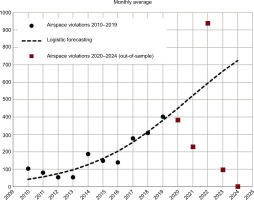Introduction
Our earlier paper on this topic (Symeonidis and Zombanakis, 2020) was aimed at predicting the pattern of behaviour displayed by Turkey, involving repeated attacks against the sovereign Hellenic airspace. The paper was based on the Weibull (1951) distribution. In the paper, we used a 2009–2019 monthly dataset for Hellenic airspace violations by Turkish aircraft. The purpose was to provide a forecasting model for the average monthly violations per year, with the forecast being quite successful for the 2020−2022 period that followed. Not only did the model capture the rapid increase of the average monthly violations but the out-of-sample data points also depicted a trend faithfully represented by the logistic function. The full 5-year out- of-sample average of monthly airspace violations was forecasted to reach approximately 600.
We must stress, however, that the 2023 and 2024 data points showed a shift in the underlying behaviour by Turkish aircraft. We owe it to the readers of this journal, therefore, to provide an explanation for this shift and, thus, revise our models and forecasts for these years. Such an update has become necessary, given the recent efforts for a rapprochement between the two sides materialising as the so-called Athens Declaration on Friendly Relations and Good-Neighbourliness, commonly known as the Athens Agreement. This agreement follows the pressures exercised within the North Atlantic Treaty Organization (NATO) framework, 4 years after the publication of our paper mentioned above.
This note will proceed as follows: First, we shall remind the readers of our forecasts concerning the Hellenic flight information region (FIR) violations by Turkish aircraft made in 2020. Second, we shall attempt to refresh these forecasts on the basis of an updated database and the alternatives that Turkey may use to challenge the Hellenic sovereignty in the Aegean. Third, we shall compare the forecasts made in our original paper to those of the present note. Finally, we shall assess the financial gains obtained by the two sides (Greece and Turkey) following the rapprochement mentioned above after the so called Athens Agreement.
Background
In the 2020 paper, we used a 2009–2019 monthly dataset for Hellenic airspace violations by Turkish aircraft. The purpose was to provide a forecasting model for the average monthly violations per year. Based on historical, political, and economic factors, we borrowed ideas from population growth and used the logistic model with an upper bound (“carrying capacity”) of 1,000 monthly violations. The least-squares best fit model for the 2009–2019 dataset was given by the following equation:
As shown in Figure A1 in Appendix I, the forecast was quite successful for the 2020-2022 period. Not only did the model capture the rapid increase of the average monthly violations but the out-of-sample data points also depicted a trend that is faithfully represented by the logistic function. The full 5-year out-of-sample average of monthly airspace violations was forecasted to reach 592.
Latest developments
Following the so-called Athens Agreement,1 the 2023 and 2024 data points showed a shift in the underlying behaviour by the Turkish side. Therefore, we need to revise our models and forecasts. This behaviour could be explained on the basis of the Political Realism strategy exercised by Turkey (Grigoriadis, 2022; Kubicek, 2022), based on which violations of Hellenic airspace and engagements with Hellenic Air Force (HAF) aircraft are not the only forms of geopolitical pressure. In this regard, alternative ways to challenge the Hellenic sovereignty in the area have been devised, such as the violation by Turkish ships of Hellenic territorial waters. The latest form of pressure, however, seems to take the form of a hybrid warfare, expressed as massive influx of illegal emigrants from Turkey (Bachmann and Paphiti, 2021; Kotoulas and Pusztai, 2020). To include these alternatives in our forecasting exercise, we ran a simple ordinary least squares (OLS) function for the 2010–2022 period (Appendix II, Table A1), with the FIR violations being the dependent variable and the determinants chosen based on the Political Realism theory,2 which explains the sustained and increasing pressure exercised by Turkey using different methods. Our choice of determinants is supported by the Granger causality findings between them and the FIR variable.
These findings are indicative of the reasoning behind the dramatic reduction of the Hellenic FIR violations by the Turkish Air Force (THK). The reduction is beneficial to both sides, but it has led to various alternative pressure means by Turkey. It appears that the fuel cost for the FIR violation policy (represented by the Dubai oil price index multiplied by the exchange rate of the Turkish lira to the US dollar) has been hard for Turkey to sustain (DUBAI × ER), given the rapid depreciation of the Turkish lira.3 Our estimates point out that the geopolitical environment (GPR × FIR) has also weighted heavily on such tactics (Dursun-Özkanca, 2022), favouring the hybrid warfare method, in the form of sending large numbers of emigrants to the European Union (EU) via Greece (LAND), which is much cheaper. The forecasts derived using these estimates, in the light of new developments that take into consideration the various pressure alternatives employed by Turkey, lead to a lower monthly average figure of airspace violations (about 400), as expected, compared to the earlier forecasting attempt when Turkey exclusively employed the Hellenic FIR violation strategy, without taking alternatives into consideration (see Appendix II, Table A2).
Table 1
Variables description.
| Variable notation | Variable explanation | Source |
|---|---|---|
| DUBAI × ER | International Monetary Fund, Global price of Dubai Crude at Turkish lira prices | https://fred.stlouisfed.org/series/POILDUBUSDM https://fred.stlouisfed.org/series/CCUSMA02TRM618N |
| GPR × FIR | Geopolitical Risk Index | https://www.policyuncertainty.com/gpr.html |
| LAND | Number of Illegal entries through the Hellenic borders | Hellenic Sea Borders Protection Division (dapthas.c@hcg.gr) archive.data.gov.gr |
| SEA | Hellenic maritime borders violations | https://geetha.mil.gr/paravaseis-paraviaseis/thalassia-symvanta-archeio-paraviaseon/ |
| SYRIA | Dummy variable for the Syrian crisis |
Discussion and Conclusions
Our forecasts point to a monthly average of about 400 airspace violations. This number is lower than that in our original paper (Symeonidis and Zombanakis, 2020); however, an update is provided for the 2020–2022 period using Equations (1) and (2) (Appendix II).
Since the cases of Hellenic FIR violations have dropped to almost zero, following the so-called Athens Agreement, the monthly benefits in terms of energy savings for the two sides may be calculated as follows: Given our forecasts implemented as described in the above paragraph, the monthly fuel cost savings for Greece will be about 4 million US dollars and that for Turkey about 3.6 million US dollars.4 This means that for the forecasted period of 16 months (January 2023 to June 2024), the total benefit will amount to US$64,000,000 for Greece and US$57,600,000 for Turkey.
Equations (1) and (2) in Appendix II are also useful to indicate the following:
For the 2010–2022 period, the fuel cost for the THK calculated in terms of the local Turkish lira (DUBAI × ER) is significant, and minimising the number of Hellenic FIR violations has been very much welcome. Even more significant is the geopolitical threat (GPR × FIR) linked to allocating the Turkish aircraft, depending on the needs in the area, especially in the Syrian front, as shown in Equation (1), where the relevant dummy appears to be strongly significant at a 5% level.
Alternatives to violating the Hellenic FIR are available to Turkey based on its political neorealism (or structural realism) policies (Grigoriadis, 2022; Kubicek, 2022). Thus, based on the estimates presented in Appendix II, another way of challenging the Hellenic sovereignty in the area is the violation by Turkish ships of Hellenic territorial waters (SEA), a variable which also appears to be quite significant.
The latest form of pressure, however, seems to take the form of a hybrid warfare, expressed as massive influx of illegal emigrants from Turkey (LAND). However, this Turkish policy is affected by a certain time lag, given the completely different form of pressure and the means to exercise it (Kuschminder and Waidler, 2020; Ruiz and Vargas-Silva, 2013; Tudoroiu, 2017).
In terms of concluding remarks, we have shown that our forecasts on the issue of the Hellenic FIR violations by Turkish aircraft have been successful in describing the pressure exercised from 2010 to 2022. The so-called Athens Agreement has introduced a break in the series, which has affected the pattern of this pressure on the Hellenic sovereignty. The new pattern introduced to challenge this sovereignty appears to be cheaper but equally, if not more, effective; it takes the form of sea border violations and massive forced emigration from Turkey to the EU via Greece.





